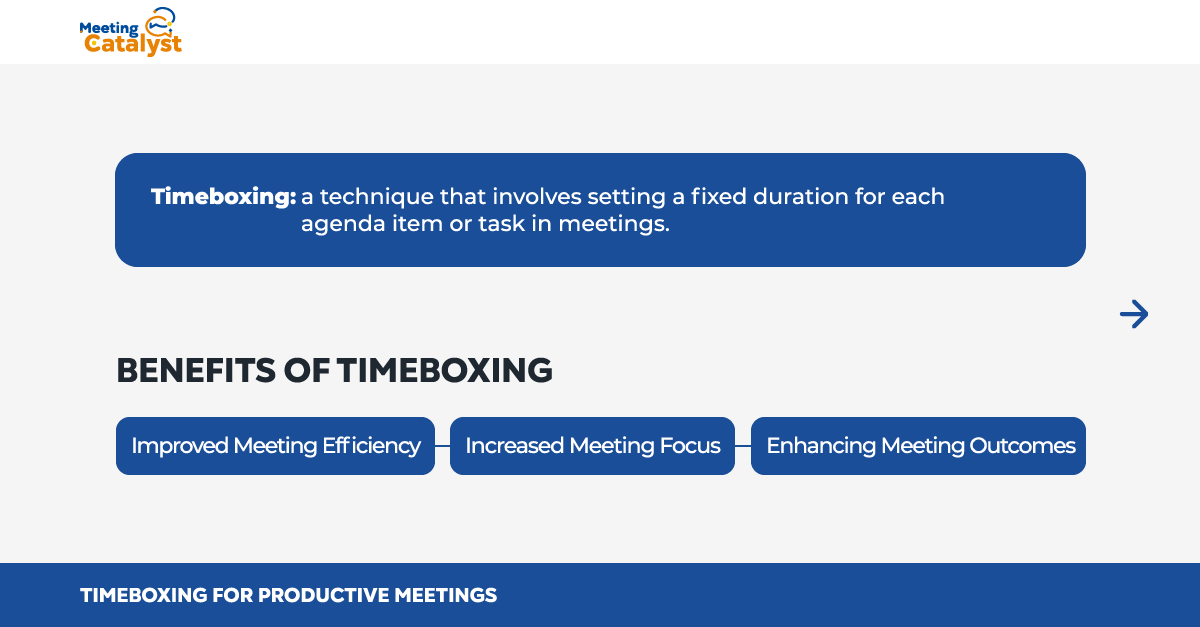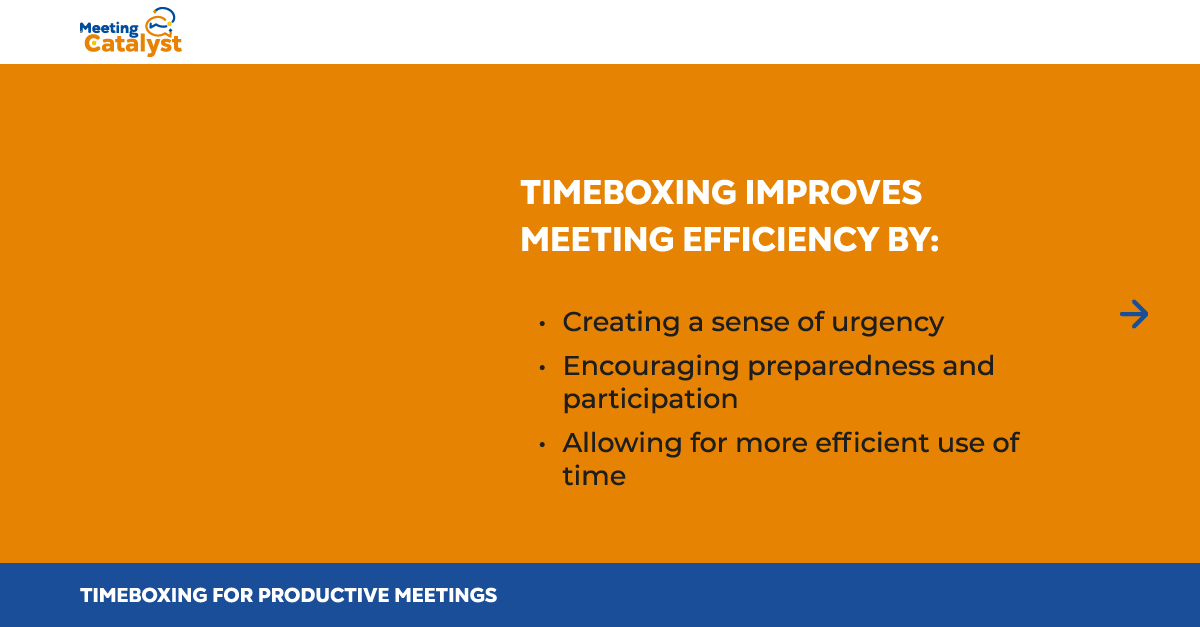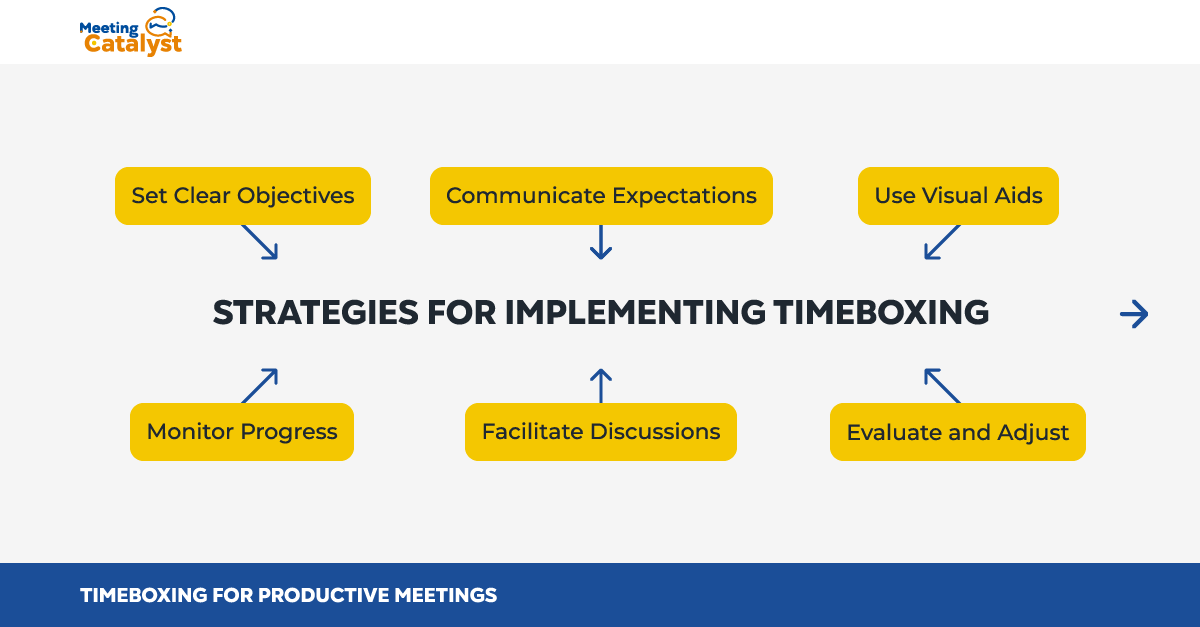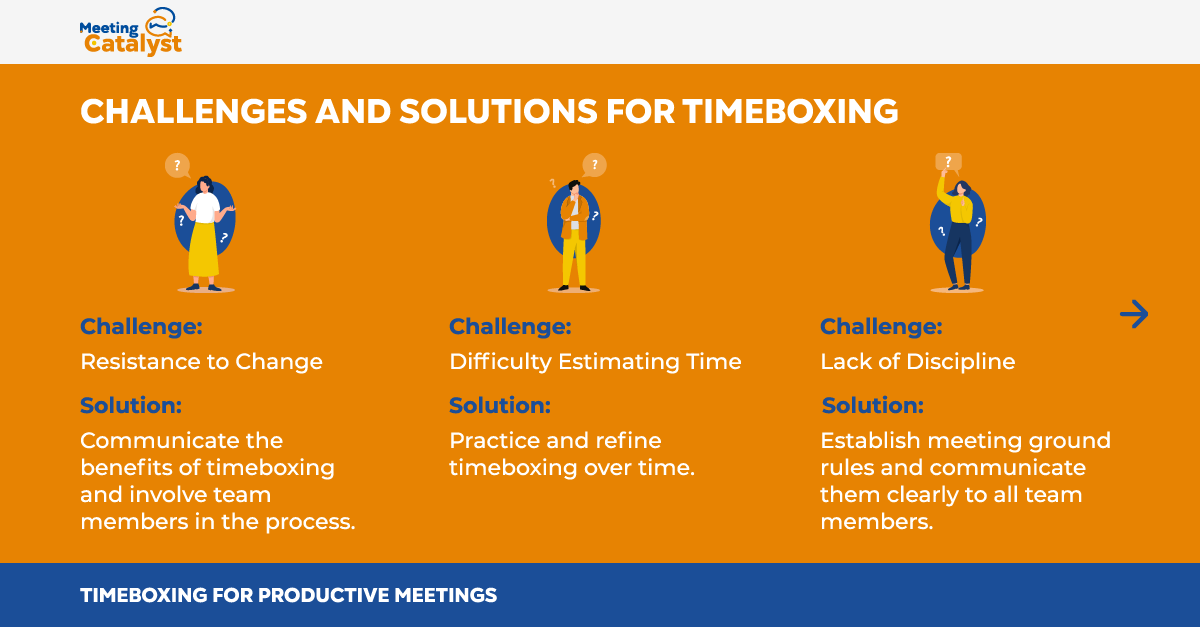The Benefits of Timeboxing Your Meetings

Introduction
In today's fast-paced business world, effective meeting management is crucial for organizational success. One technique that has gained traction among team leaders is timeboxing - a powerful approach to controlling meeting durations and ensuring a focused, efficient discussion. By allocating a specific amount of time to each agenda item, timeboxing can revolutionize the way you conduct meetings, leading to increased productivity and better outcomes. In this article, we'll explore the numerous benefits of timeboxing your meetings and provide practical guidance on implementing this technique in your organization.
In the following sections, we will cover:
- Understanding Timeboxing
- Improved Meeting Efficiency
- Increased Meeting Focus
- Better Meeting Preparation
- Enhancing Meeting Outcomes
- Strategies for Implementing Timeboxing
- Challenges and Solutions for Timeboxing
By the end of this blog post, you will have a comprehensive understanding of timeboxing, its benefits, and how to implement it effectively in your meetings. Get ready to transform your team's approach to meetings and unlock the true potential of timeboxing.
Understanding Timeboxing

Before diving into the benefits of timeboxing, let's first define what it is and how it works in the context of meetings. Timeboxing is a simple yet effective time management technique that involves allocating a fixed amount of time to a specific task or agenda item, ensuring that discussions remain focused and on schedule.
Definition of Timeboxing
In the context of meetings, timeboxing involves:
- Assigning a specific duration to each agenda item
- Sticking to the allocated time for each topic
- Moving on to the next item once the allotted time has elapsed
Principles Behind Timeboxing
Timeboxing is based on the following key principles:
- Clarity: Each agenda item should have a clear purpose, objective, and desired outcome.
- Urgency: By limiting the time allocated to each topic, participants are encouraged to prioritize their thoughts, leading to more concise and focused discussions.
- Discipline: Timeboxing requires commitment from all participants to respect the time limits and maintain the focus of the meeting.
Benefits of Timeboxing in Meetings
There are numerous benefits to implementing timeboxing in meetings, including:
- Improved efficiency and productivity
- Increased focus and engagement
- Better meeting preparation
- Enhanced meeting outcomes
By understanding the principles behind timeboxing and its potential benefits, you can start implementing this technique in your meetings and experience a noticeable improvement in their effectiveness. In the following sections, we'll delve deeper into the specific benefits and best practices for timeboxing your meetings.
Improved Meeting Efficiency

One of the most significant benefits of timeboxing is the improvement in meeting efficiency. By allocating a specific time to each agenda item, meetings are kept on track, and discussions remain focused and productive. Let's explore how timeboxing enhances meeting efficiency.
Keeping Meetings on Track
Timeboxing helps maintain a steady pace during meetings by:
- Preventing discussions from veering off course
- Discouraging long-winded, unfocused conversations
- Ensuring that every agenda item is addressed within the allotted time
This approach prevents meetings from dragging on and reduces the likelihood of essential topics being left unaddressed due to time constraints.
Fostering Productive Conversations
With a clear time limit in place, participants are encouraged to prioritize their thoughts and contributions, leading to more concise and focused discussions. Timeboxing promotes the following behaviors in meeting participants:
- Staying on topic
- Making relevant and valuable contributions
- Respecting the time limits of their peers
Timeboxing your meetings can significantly enhance their efficiency, leading to more productive conversations and better use of everyone's time. In the next sections, we'll explore additional benefits of timeboxing and best practices for implementing this technique in your meetings.
Increased Meeting Focus

Another key benefit of timeboxing is the increased focus it brings to meetings. Participants are more likely to stay engaged, present, and attentive when they know that each agenda item has a predetermined time limit. Let's delve deeper into how timeboxing can sharpen the focus during meetings.
Encouraging Active Participation
When meetings are timeboxed, participants are more likely to:
- Pay attention to the ongoing discussion
- Quickly identify relevant points to contribute
- Be mindful of their speaking time, which allows for more balanced participation
Timeboxing creates a sense of urgency that encourages team members to stay engaged and contribute meaningfully to the conversation.
Fostering a Results-Oriented Mindset
Timeboxing instills a results-oriented mindset in meeting participants. Knowing that there is a limited amount of time to discuss each topic, attendees are more likely to focus on finding solutions, making decisions, and moving forward. This mindset promotes:
- A problem-solving approach to discussions
- A commitment to making tangible progress during the meeting
- A clear understanding of each meeting's objectives and desired outcomes
Incorporating timeboxing into your meeting structure can help maintain focus and drive results-oriented discussions. As we continue, we'll explore how timeboxing can also improve meeting preparation and outcomes.
Better Meeting Preparation
Timeboxing is a powerful tool that can significantly improve meeting preparation, leading to more productive and successful meetings. By allocating a specific time frame to each agenda item, team members are encouraged to come to meetings well-prepared and ready to engage in focused discussions. Let's examine how timeboxing can enhance meeting preparation.
Streamlined Agenda Creation
Timeboxing helps in creating well-structured agendas by:
- Ensuring that each agenda item has a clear purpose and desired outcome
- Encouraging organizers to prioritize topics based on their importance and relevance
- Allocating appropriate time for each topic, preventing unnecessary tangents or drawn-out discussions
A well-planned agenda sets the stage for a productive meeting and ensures that all relevant topics are covered within the allotted time.
Increased Participant Engagement
Timeboxing contributes to increased participant engagement by:
- Encouraging team members to come prepared with relevant information and ideas to contribute
- Promoting active participation, as everyone is aware of the time constraints for each topic
- Ensuring that each participant understands their role and expectations during the meeting
Better preparation leads to more meaningful discussions and improved decision-making.
Enhanced Meeting Outcomes
When meetings are properly prepared for, the outcomes are likely to be more successful. Timeboxing contributes to improved outcomes by:
- Ensuring that meetings stay on track and accomplish their objectives
- Encouraging participants to make decisions and take action within the allotted time
- Facilitating a sense of accomplishment and progress at the end of each meeting
By incorporating timeboxing into your meeting preparation process, you can ensure that your meetings are well-planned, focused, and productive, ultimately leading to better outcomes.
Enhancing Meeting Outcomes
Timeboxing has a significant impact on meeting outcomes, empowering teams to make better decisions and accomplish more in less time. By keeping meetings focused and time-bound, timeboxing ensures that team members stay engaged and participate actively in discussions. Let's delve into how timeboxing can enhance meeting outcomes.
Better Decision-Making
Timeboxing can improve decision-making by:
- Encouraging participants to come prepared with relevant information and well-thought-out proposals
- Fostering a sense of urgency, which can help teams make decisions faster and more efficiently
- Promoting a focused and structured discussion, enabling teams to weigh options and make informed choices
Better decision-making leads to more successful project outcomes and a more efficient use of resources.
Increased Accomplishments
Timeboxing promotes a results-oriented mindset, allowing teams to:
- Prioritize tasks and allocate resources more effectively
- Set and achieve short-term goals, leading to a sense of accomplishment
- Make tangible progress toward long-term objectives by consistently completing tasks within the designated timeframes
When teams are more focused on accomplishing specific objectives, they are better equipped to drive projects forward and achieve their goals.
Embracing timeboxing as part of your meeting management strategy can significantly enhance your team's ability to make better decisions and achieve their goals, ultimately leading to more successful projects and a more efficient organization.
Strategies for Implementing Timeboxing

Successfully implementing timeboxing in your meetings requires a thoughtful approach and an understanding of best practices. In this section, we'll explore various strategies and tips to help you effectively incorporate timeboxing into your meeting culture.
Set Clear Objectives
Before timeboxing your meeting, ensure that you have:
- Defined the meeting's purpose and goals
- Identified the specific topics and tasks that need to be addressed
- Established the desired outcomes for each agenda item
By setting clear objectives, you'll be better equipped to allocate time to each agenda item, ensuring that discussions remain focused and productive.
Communicate Expectations
Transparently communicate the timeboxing approach and expectations to all meeting participants. This includes:
- Informing participants about the allotted time for each agenda item
- Encouraging them to come prepared and actively contribute during the allotted time
- Emphasizing the importance of staying on track and adhering to the timebox
Effective communication helps build buy-in and ensures that everyone is aligned with the timeboxing process.
Use Timeboxing Tools
Leverage tools and technology to facilitate timeboxing during meetings. Examples include:
- Using a timer or stopwatch to track time spent on each agenda item
- Utilizing digital tools, such as meeting management software or apps with built-in timeboxing features
- Displaying a visible countdown timer to keep participants aware of the remaining time
By integrating timeboxing tools, you can help keep meetings on track and ensure that participants remain aware of the time constraints.
Monitor and Adjust
After implementing timeboxing, it's essential to:
- Regularly review the effectiveness of your time allocations
- Seek feedback from meeting participants on the timeboxing process
- Make adjustments as needed to improve the efficiency and effectiveness of your meetings
Monitoring and adjusting your timeboxing approach will help you refine the process and enhance its overall impact on your meetings.
Challenges and Solutions for Timeboxing

While timeboxing can greatly improve your meetings, it's important to recognize the potential challenges that may arise during implementation. In this section, we'll discuss common obstacles and provide strategies for overcoming them.
Resistance to Change
Challenge: Team members may resist the idea of timeboxing, viewing it as a constraint that stifles discussion or creativity.
Solution: To overcome resistance to change:
- Clearly communicate the benefits of timeboxing and how it can improve meeting efficiency and effectiveness
- Encourage open dialogue about concerns and address any misconceptions
- Start by introducing timeboxing gradually, allowing team members to adjust and become more comfortable with the process
Difficulty in Estimating Time
Challenge: Accurately estimating the time needed for agenda items can be difficult, especially when discussing complex or unfamiliar topics.
Solution: To address estimation challenges:
- Begin by allocating a conservative amount of time for each agenda item, and then adjust as needed based on experience
- Encourage meeting participants to help with time estimation, as they may have valuable insights into the complexity of certain topics
- Monitor time allocation closely and refine your estimates over time
Balancing Time Constraints with Flexibility
Challenge: Striking the right balance between time constraints and flexibility can be difficult, as rigidly enforcing time limits may stifle discussion or hinder problem-solving.
Solution: To maintain the right balance:
- Allow for a degree of flexibility in your timeboxing approach, giving some leeway when necessary to ensure that critical issues are fully addressed
- Encourage participants to continue discussions outside the meeting if they need more time to explore a topic
- Set aside some buffer time within the meeting to accommodate unforeseen discussions or issues
Conclusion
In conclusion, timeboxing is a powerful tool that can greatly enhance the effectiveness of your meetings. By implementing timeboxing, you can experience the following benefits:
- Improved meeting efficiency
- Increased meeting focus
- Better meeting preparation
- Enhanced meeting outcomes
Moreover, by understanding the potential challenges of timeboxing and employing strategies to overcome them, you can successfully integrate this technique into your meeting management processes.
As a business or team leader, it's essential to continually seek ways to optimize your meetings and ensure that they contribute to your organization's goals. Timeboxing is one such method that can make a significant difference in your meeting outcomes. By embracing timeboxing and its benefits, you can create a more productive and focused work environment, ultimately helping your team achieve greater success.
Take the first step towards transforming your meetings by implementing timeboxing today. Your team, and your organization, will thank you for it.